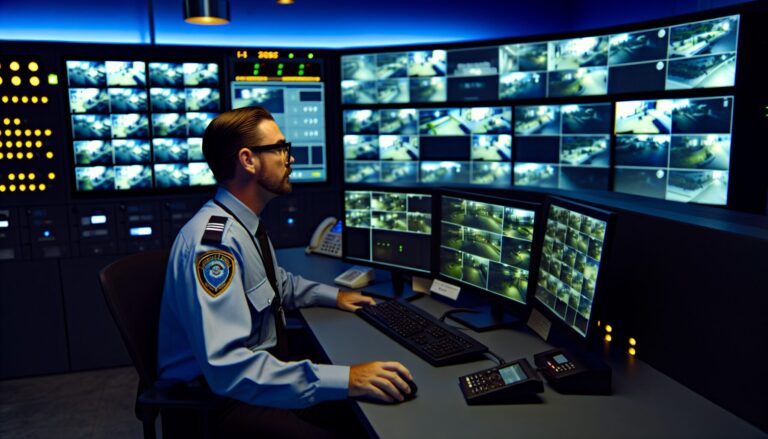Ensuring security for hospital settings involves safeguarding patients, staff, and critical data around the clock. In this article, we delve into the top security systems and protocols that strike the balance between accessibility and privacy, detailing how hospitals can utilize access control, continuous monitoring, and emergency response measures to protect against internal and external threats.
Hospital Security Overview
Hospital security balances accessibility with safeguarding data and protecting individuals, utilizing advanced technologies such as Access Control Systems integrated with real-time monitoring and emergency response protocols to minimize unauthorized access and enhance reaction to threats.
Security systems are increasingly reliant on artificial intelligence with features like facial recognition and behavior detection in IP cameras, and integrated systems for more effective monitoring, video analytics capabilities for safety and operational decisions, along with dynamic access rights adjustments catering to evolving workplace environments.
Compliance with regulations such as HIPAA is crucial for hospital data security, involving secure logical access controls, encryption, and adherence to privacy rules for Protected Health Information (PHI), requiring staff training on security protocols to effectively manage and respond to threats within hospital settings.
Hospital Security Systems Overview
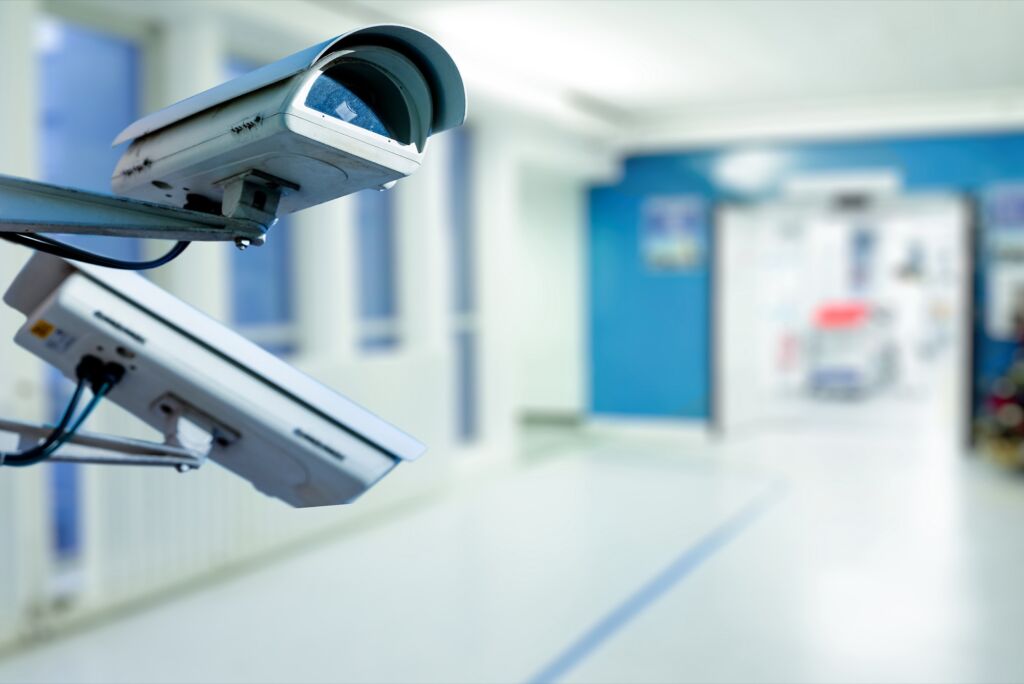
Security in healthcare facilities is a complex affair. Hospitals face unique challenges, balancing the need for accessibility with the necessity of safeguarding sensitive data and protecting patients and staff. Access control, a critical security technique, is at the heart of this balance, managing who or what can view or use resources to minimize risks. The goal of such systems is to limit unauthorized access to physical and logical systems, thereby protecting against internal and external threats.
Compliance with regulations such as HIPAA is also essential, requiring robust physical security controls to protect Patient Health Information (PHI).
Access Control in Healthcare Facilities
Hospitals utilize a range of tools to manage access control, including:
- Sophisticated software that manages entry and exit to various areas, utilizing role-based access control and features such as single button lockdown
- Keycard systems
- Biometric readers
- PIN codes
- ID badges
These tools help limit access to sensitive areas and manage healthcare worker and visitor access levels.
These advanced systems not only restrict unauthorized entry but also contain instances of violence and record access information for regulatory compliance purposes.
Monitoring Hospital Safety 24/7
Modern hospitals are never truly ‘closed’. Thus, proactive monitoring must be maintained 24/7/365, ensuring continuous security oversight in the hospital setting. Advanced video technology enables hospital security cameras to be perpetually active, allowing for ongoing recording and live monitoring. AI security cameras process video data in real-time, identifying potential threats swiftly and managing crowds in public areas efficiently.
The integration of security systems enhances real-time and remote monitoring, offering centralized control and enabling instant reaction to security breaches.
Emergency Protocols for Quick Response
In the face of an emergency, every second counts. That’s where emergency protocols come into play. A single button lockdown allows for the immediate securing of the facility with a single action, enhancing the scalability and responsiveness during an emergency.
Mobile devices receive instant security alerts to ensure staff are quickly informed of emergency situations. Institutional protocols establish clear roles during an emergency, facilitating a coordinated and effective response.
Advanced Surveillance Technologies
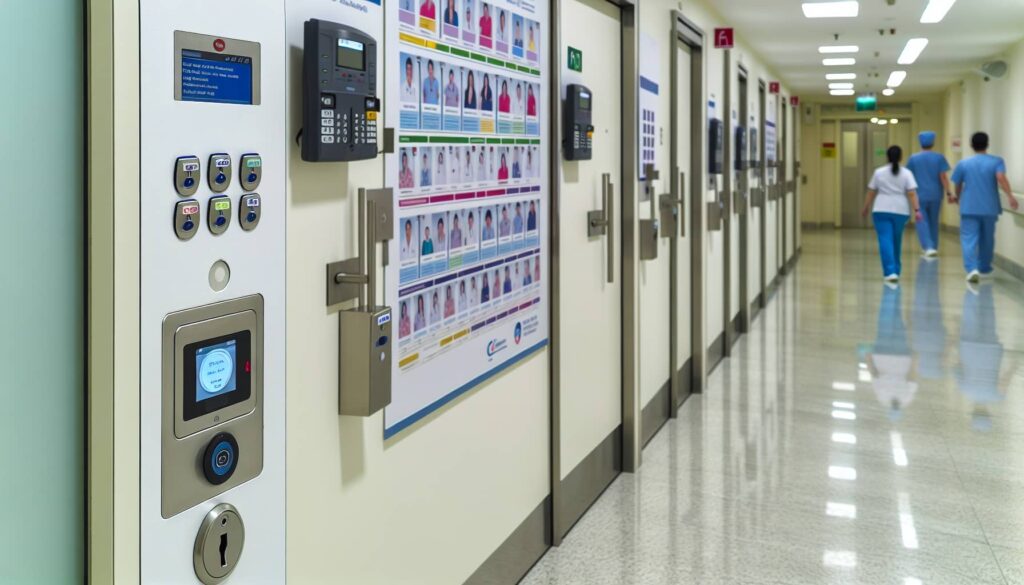
In the digital age, surveillance technologies have evolved far beyond simple video cameras. Hospitals now utilize IP security cameras equipped with AI-enhanced features such as behavior detection and facial recognition to significantly boost security. Nocturnal IP Security Cameras offer real-time 4K resolution, motorized varifocal lenses, and ePoE technology for comprehensive surveillance.
But it’s not just about cameras. The integration of access control systems and a security camera system with video surveillance provides a more secure environment by jointly confirming identities and controlling entry at various hospital sections. This integrated system, which includes security camera systems, mitigates risks by enabling instant responses to events like unauthorized access attempts, ultimately enhancing the hospital’s capability to monitor and protect its environment.
AI-Enhanced Observation
From monitoring patient behavior to recognizing potential threats, AI-supported IP cameras have become an indispensable tool in hospital security. These AI security camera systems use facial recognition to track individuals and behavior detection to alert on potential incidents. When restricted areas are accessed, AI security cameras can provide instant alerts to enact emergency protocols.
They also actively track guest movement, delivering continuous surveillance throughout hospital property.
Real-Time Tracking and Analysis
Real-time tracking systems offer more than just constant surveillance. They provide:
- In-depth analysis of video streams
- Examination of images pixel by pixel to detect, track, and classify objects in a scene
- Intelligent adaptation to changes in the hospital environment
- Identification of unusual or abnormal movements, helping ensure security.
A centralized data system from integrated access control and surveillance offers several benefits, including:
- Reducing manual work by automatically identifying security concerns such as tailgating hot spots
- Maximizing space utilization
- Security cameras set rule-based actions depending on the person being tracked, enhancing the effectiveness of real-time security management
- Video analytics capabilities extend to monitoring traffic flow and movement of people, generating valuable data for making safety and operational decisions within the hospital environment.
Integrated Access Management
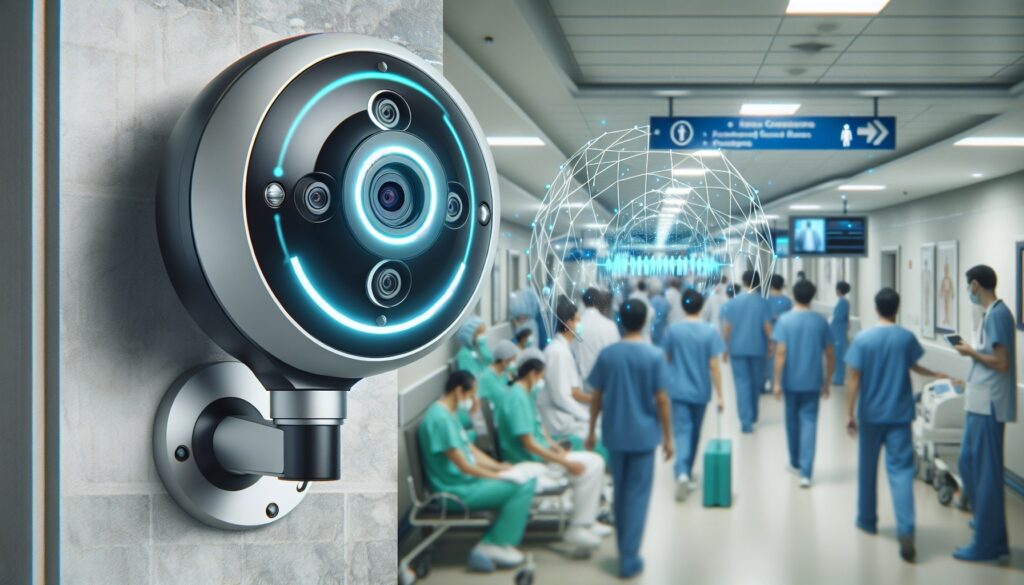
In an era of interconnected systems, integrated access management systems have become the norm. These systems centralize the management of:
- Surveillance cameras
- Access control
- Intrusion sensors
- Fire alarms
into a unified interface, improving visibility over hospital security operations and enhancing the efficiency of managing these systems. They combine access control systems with video management systems, tying video clips to specific access events, and enabling focus on strategic locations and high-risk areas with electronic locks and automated compliance logging.
Visitor management functions within access control systems are advanced to manage visitor access effectively, including features like mobile badge assignment by roles, health questionnaires before arrival, and remote management capabilities to control and monitor access on the go.
Badge Access Control Systems
Badge access control systems are a common sight in hospitals. These systems use electronic ID badges, alongside magnetic or electric door locks and card readers, to regulate access to specific areas within a hospital. Various credential types such as RFID badges, swipe badges, and scannable badges like QR or barcodes are utilized in badge systems to authenticate access.
Badge access control systems often interface with barriers like doors and gates, and can:
- Alert security personnel via mobile devices when unauthorized access attempts occur
- Provide a record of who entered or exited a specific area and at what time
- Restrict access to certain areas based on an individual’s role or clearance level
- Improve overall security by reducing the risk of unauthorized entry through electronic access control systems
Despite potential challenges associated with high initial costs, susceptibility to technical glitches, requirements of comprehensive employee training, and ongoing maintenance, these systems are an essential part of hospital security.
Dynamic Access Rights Adjustments
As workplaces evolve, so too must access rights. Dynamic authorization in hospitals leverages contextual factors such as:
- User identity
- Role
- Location
- Device
An access control system provides a detailed level of control over access rights, ensuring that employees can perform their defined business functions effectively. These systems are also capable of automatically adjusting permissions based on predefined schedules, aligning employee access with role-specific duties or during emergency situations.
Adaptive access control policies enhance these systems by automatically responding to changes in user behavior or system conditions, maintaining the relevance of access permissions. Real-time policy enforcement through dynamic access rights adjustments strengthens security by ensuring a swift organizational response to observed changes. Incorporating attribute based access control, discretionary access control, and mandatory access control further enhances the effectiveness of these access control policies.
Responding to Threats in Healthcare Settings
Reacting appropriately to threats is an integral part of hospital security. Hospitals must:
- Conduct security risk assessments
- Develop comprehensive security plans
- Train staff on policies
- Conduct regular security audits
Security guards are instrumental in managing violent and aggressive behavior, reinforcing the safety of patients, and staff within healthcare settings.
Automated Threat Detection

The development of AI technology has led to the rise of automated threat detection. AI security cameras utilize deep machine learning to analyze behaviors, enabling them to alert to specific actions such as theft, recognize faces, and identify suspicious or abnormal behaviors.
Facial recognition is applied in AI security cameras within hospitals to enhance security measures by:
- Scanning faces
- Cross-referencing them with a database to pinpoint potential threats
- Detecting unauthorized individuals or unusual activity
- Triggering rule-based actions, such as locking down affected areas or notifying security personnel, to preemptively address potential threats.
Incident Management Tools
In the event of an incident, effective management tools are key. Incident management systems, such as the one provided by Radar Healthcare, enable healthcare professionals to efficiently document and analyze incidents, facilitating a proactive risk management strategy. These software provide a host of features including:
- A comprehensive event list with sorting and filtering capabilities
- A detailed event activity log
- Role-based access control to uphold data integrity and confidentiality
Advanced AI video analytics tools assist security teams in identifying threats, tracking suspects in real-time, and timely response to incidents within hospital premises.
Data Protection and Compliance
Beyond physical security, hospitals must ensure the protection of sensitive data, including customer data. The protection of patient information is vital to maintain confidentiality and uphold the trust placed in healthcare facilities.
Security systems in hospitals must align with HIPAA regulations to safeguard sensitive health data adequately. Access control policies and technology are essential to ensure the protection of confidential patient information in compliance with government regulations.
Securing Sensitive Patient Data
Protecting sensitive patient data is a paramount concern. Platforms like MixMode’s Third Wave AI autonomously learn and adapt to healthcare environments, detecting threats in real time to protect sensitive patient information.
Logical access control systems involving usernames and passwords along with multi-factor authentication help protect electronic information from unauthorized access. To comply with HIPAA, encryption of data is enforced both at rest and during transit, ensuring data security even in the event of unauthorized interception.
Adherence to Regulatory Standards
Compliance with regulatory standards is not just a legal obligation; it’s a cornerstone of trust in healthcare. Hospitals are legally mandated to protect personnel, patients, and visitors, with oversight provided by the Office for Civil Rights for HIPAA Privacy Rule compliance. Adherence to industry regulations such as HIPAA, GDPR, and PCI DSS is facilitated through secure access control systems and real-time policy enforcement.
Under HIPAA, the use or disclosure of Protected Health Information (PHI) is generally prohibited without written authorization, except for public health purposes or by law.
Tailoring Security to Hospital Needs
The one-size-fits-all approach rarely works in hospital security. Customizing security systems to cater to specific hospital needs can help address concerns like violence prevention, theft deterrence, and medication security while ensuring HIPAA compliance.
Integrated hospital security systems can be expanded with software solutions for visitor management, wellness screenings, temperature checks, and IoT devices for enhanced security coverage.
Customizable Surveillance Solutions
Modern surveillance solutions can be tailored to fit specific hospital needs. Features like voice recognition in AI security cameras allow users to interact with the camera and search for specific footage.
The use of voice recognition can enhance the flexibility of surveillance systems to quickly identify and review incidents in high-risk areas.
Scalable Access Control Models
A hospital’s needs are constantly evolving, and its security systems must keep pace. Access control systems in hospitals can be scaled and customized to secure entrances, elevators, and restricted areas as the facility grows or changes. Scalable access control solutions can help manage secure access especially as staff changes occur, by including features for automated removal of inactive credentials.
Cloud-based access control systems, like those provided by Genea Security, offer scalability and ease of management, adjusting security measures as healthcare facilities grow.
Training and Empowering Hospital Staff
The best security systems can only be as effective as the people who operate them. Training hospital staff on security protocols enhances their ability to understand and operate security systems effectively, ensuring hospital safety.
Emergency department staff should receive specific education on safety measures, predictors of violence, and techniques to de-escalate violent situations.
Security Awareness Programs
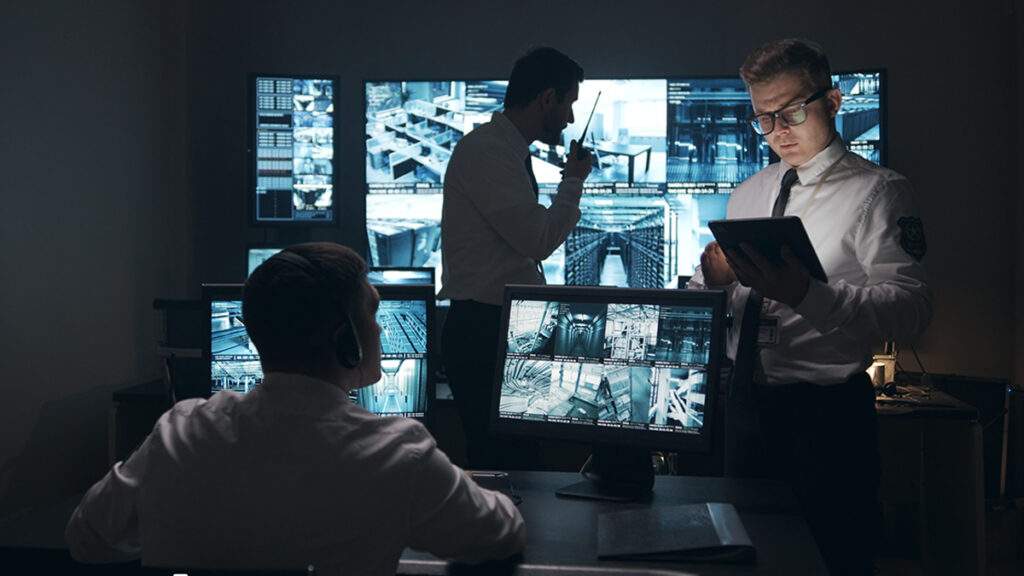
Education is a critical aspect of security. Hospital security plans must prioritize personnel training to mitigate risks of aggressive or violent behavior, and regular emergency drills familiarize staff with natural disasters, mass casualty incidents, and equipment failures. Simulation drills and tabletop exercises are integral to training hospital staff, helping them better understand their roles and the protocols to follow during emergencies.
Security awareness extends to all employees, emphasizing the importance of cybersecurity practices, the secure handling of protected health information, and awareness of supply chain attack risks.
Role Assignments and Responsibilities
Every member of a hospital’s staff has a role to play in maintaining security. Hospitals require a team of adequately trained security personnel to effectively carry out their security strategies and manage any violent disturbances. Given their critical role in safeguarding hospital safety, it is important to provide security guards with proper training and support.
Summary
In conclusion, the importance of security in the healthcare sector cannot be overstated. From access control to data protection, hospitals are leveraging advanced technologies and integrated systems to enhance safety, comply with regulations, and maintain the trust of patients and staff. Through training and empowering staff, hospitals can ensure these systems are used effectively. While threats continue to evolve, so too do the innovative solutions designed to keep healthcare facilities secure.
Frequently Asked Questions
What are the three 3 types of access control?
The three types of access control are Role-Based Access Control (RBAC), Attribute-Based Access Control (ABAC), and Discretionary Access Control (DAC). Each type provides different methods for managing and restricting access to resources.
What are the security measures to be taken in a hospital?
Security measures in a hospital include procedures for workplace safety, wearable panic buttons, access control, video surveillance, record-keeping of staff, patients, and assets, the availability of security personnel, identification checks, personal information security, and regular checks for infections and falls. These measures are crucial to maintaining a safe and secure environment within the hospital.
Do hospitals have their own security?
Yes, hospitals often have their own experienced and licensed security guards who control access points and monitor people entering and exiting to deter potential crime. This helps ensure a safe environment for patients and staff.
What is access control in the context of hospital security?
Access control in hospital security manages resource access to minimize risks, utilizing keycard systems, biometric readers, PIN codes, and ID badges. Access control is crucial in controlling entry to sensitive areas and managing healthcare worker and visitor access levels.
How does AI enhance hospital surveillance systems?
AI enhances hospital surveillance systems by enabling real-time tracking and analysis of behavior using facial recognition and behavior detection in IP cameras, as well as providing instant alerts for potential incidents in restricted areas. This technology can help hospitals ensure security and respond to emergencies promptly.

